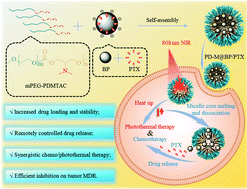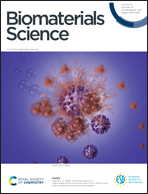Black phosphorus assisted polyionic micelles with efficient PTX loading for remotely controlled release and synergistic treatment of drug-resistant tumors†
Abstract
Nanomedicines have been widely used in the effective delivery of chemotherapeutic drugs due to their advantages such as increasing the half-life of drugs, selectively targeting tumor tissues, and thus reducing systemic toxicity. However, the low drug entrapment rate and the difficulty of real-controlled release at tumor sites hinder their further clinical translations. Here we have developed biodegradable polyionic micelles (PD-M) to facilitate black phosphorus (BP) encapsulation (PD-M@BP) for improved drug loading. With the introduction of BP, PTX-loaded PD-M@BP (PD-M@BP/PTX) with sizes of 124–162 nm exhibited superior encapsulation efficiency over 94% and excellent colloidal stability. Meanwhile, PD-M well protected BP from fast degradation to show the good photothermal performance under near-infrared (NIR) irradiation, thus achieving the remotely controlled fast PTX release due to micelle core melting and dissociation, accompanied by the synergistic photothermal tumor therapy. The in vivo results demonstrated that the PD-M@BP/PTX nanosystem not only realized significant inhibition of multi-drug resistant (MDR) cervical tumors (HeLa/PTXR tumor) by remote NIR-regulation, but also reduced the potential damage of chemotherapeutic drugs to the whole body, rendering these hybrid nanosystems as great tools to treat MDR tumors synergistically.



 Please wait while we load your content...
Please wait while we load your content...